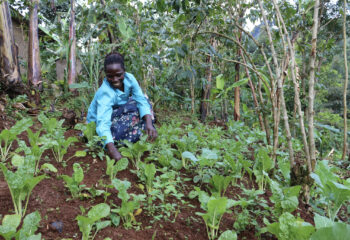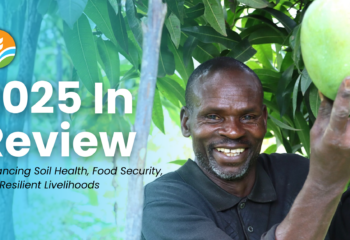
We’re celebrating the International Week of Science and Peace. As part of our festivities, we sat down with Dr. Mercy Ngunjiri for a quick chat about soil health and nutrition, specifically through a gendered lens that highlights the importance of women scientists for international development. Dr. Ngunjiri serves as a Research Agronomist and GIS Specialist for IFDC. She participates in and offers support in planning, designing, and implementing field and laboratory research experiments and trials and subsequently analyzes acquired and existing data and information. These research experiments and trials are mainly focused on balanced crop nutrition. She also supports IFDC with GIS activities, including analysis and interpretation of geospatial data and soil mapping.
What inspired you to become a scientist? What is your area of focus?
Having been born and raised in a poor rural background, I grew up seeing my mother work as a casual farm laborer. She would work from dawn to dusk just to earn a quarter to supplement what my father earned from his work as an evangelist at a local church. My parents could barely meet the family’s needs, including acquisition of farm inputs, such as fertilizers and seeds, for our small farm. Due to the small quantity of farm inputs, our farm barely produced enough to feed our family. Putting food on the table became hard, even though my mother would ration it. Poverty and food insecurity became a menace. This was agonizing for me, and the best way to retaliate was to aspire to be a scientist who could perform some “magic” and increase food security, mostly for the poor rural farmers. I really wanted to be part of a scientific team whose research was aimed at increasing food security across people’s lives, especially in developing countries.
Why is the work of female scientists particularly crucial for broadening our understanding of science and international development?
The gender bias is progressively decreasing among younger people across the world, and there has been a paradigm shift of involving women more in STEM research. To increase the spectrum of inventions and breakthroughs, more women are needed in science because they look at problems differently than men typically do and apply their emotional skills in research. Women are also more sociable than men and have a “communal” quality, which could potentially expand the focus of science to diversify and meet community needs for a more inclusive environment.
Why is it important for societies to address soil health and plant nutrition for improved food systems?
Soil is life, and among other important roles, soil supports plant life. Healthy soil is the cornerstone for productive, economical, and environmentally friendly agricultural systems. To maintain healthy soil, we need to apply the right source of nutrients, at the right rate, at the right time, and in the right place. In doing this, we need to consider all crop nutrient needs for more balanced crop nutrition. With healthy soil and balanced crop nutrition, food systems can substantially improve in both quality and quantity, which can in turn nourish people, animals, and more – feeding the growing world population.
How can research provide sustainable soil fertility-related solutions for improving livelihoods?
I believe this would be by providing sound and practical solutions to farmers. For example, sometimes research generalizes fertilizer recommendations by taking recommendations developed for one geographic area to another area with completely different soils and crop needs. Such general recommendations are difficult for farmers and policymakers to be integrate into economic decision-making. Another example would be in replacing field experiments with modeling, even where the models were built for a specific geographic area. This is more so when research fails to provide for uncertainty associated with such model outputs, and farmers and policymakers take it as the “gospel truth.”
How does your research impact the lives of farmers? Do you have any special efforts aimed at women or youth?
Our research on balanced crop nutrition has seen many farmers double, triple, and even quadruple their farm produce, which has greatly improved their livelihoods. Balanced crop nutrition ensures that different nutrients are supplied since one nutrient cannot solely deliver sufficient yield and crop quality.
Our research has a general focus on men, women, and youth. However, we are aware that women make up the majority of the agricultural workforce in many areas of the world, and ensuring that they have the right information is important. In fact, if we equip women with the right tools, training, and technology, we could see as much as a 30% increase in global food production.
What renewed commitments to soil health and plant nutrition would you like to see made internationally?
I would like to see more commitment to soil preservation and restoration of degraded soils. Soil formation and its nutrient replenishment is being exceeded by soil erosion, soil nutrient mining, and nutrient imbalance. With a growing world population and demand for food, it is imperative that we protect the foundation of our food systems – the soil!
What would you say to encourage more young women to pursue careers in soil science, agriculture, or science, in general?
Oh wow, I like this specific question because it reminds me of how my journey in soil science and agronomy started. Although filled with many uncertainties, discouragement, and a bleak outlook painted by family and friends, I realized that I had to be part of the change by breaking the stereotypes that soil science and agriculture-related courses are dirty, not meant for women, provide little to no job opportunities, and involve low-paying jobs. Today, women like me pursue careers as soil scientists, agronomists, horticulturalists, plant pathologists, and animal scientists, among others, in all employment sectors, including academia and government and private organizations. In fact, due to existing policies on offering equal employment opportunities to both women and men, it could be that there are more opportunities in the agricultural fields yet to be tapped into by women.




